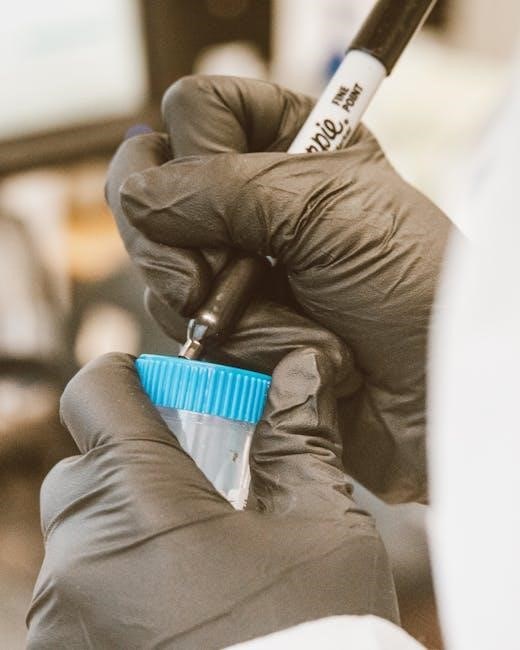organic chemistry lab survival manual zubrick
The Organic Chem Lab Survival Manual by James W. Zubrick, 11th Edition, serves as a comprehensive guide for students, offering essential practical techniques, troubleshooting tips, and safety guidance for success in organic chemistry laboratories.
1.1 Purpose of the Manual
The Organic Chem Lab Survival Manual by James W. Zubrick is designed to equip students with the essential skills and knowledge needed to excel in organic chemistry laboratories. Its primary purpose is to provide a practical, hands-on guide for navigating the challenges of lab work, emphasizing safety, proper techniques, and effective problem-solving. The manual serves as a valuable resource for undergraduate students, offering clear instructions, expert tips, and real-world applications. It bridges the gap between theoretical knowledge and practical execution, ensuring students are well-prepared to handle laboratory responsibilities confidently. By focusing on critical areas such as hazard identification, experimental design, and data interpretation, the manual aims to enhance learning and lab efficiency.
1.2 Key Features of the Guide
The Organic Chem Lab Survival Manual by James W. Zubrick offers a comprehensive approach to mastering organic chemistry lab techniques. Key features include detailed step-by-step instructions, practical examples, and expert tips for troubleshooting common challenges. The guide emphasizes safety protocols, proper use of laboratory instruments, and interpretation of spectroscopic data. It provides clear explanations of fundamental concepts, such as IR and NMR analysis, ensuring students grasp essential skills. The manual also includes real-world applications and time-saving strategies, making it an indispensable resource for both novice and advanced learners. Its concise yet thorough approach bridges the gap between theory and practice, ensuring students are well-equipped for success in the lab.
1.3 Target Audience
The Organic Chem Lab Survival Manual by James W. Zubrick is primarily designed for undergraduate students enrolled in organic chemistry courses. It caters to sophomores and juniors navigating their first or second-year lab experiences. The guide is also beneficial for graduate students seeking a refresher on fundamental techniques. Additionally, it serves as a valuable resource for educators and professionals looking to streamline lab processes. By focusing on practical applications and real-world scenarios, the manual bridges the gap between theoretical knowledge and hands-on experimentation, making it an essential tool for anyone aiming to excel in organic chemistry laboratory settings.

Essential Laboratory Techniques
The Organic Chem Lab Survival Manual by James W. Zubrick focuses on essential lab techniques, including proper use of instruments, fundamental methods, and practical applications for mastering organic chemistry experiments effectively.
2.1 Familiarity with Lab Instruments
Familiarity with lab instruments is crucial for success in organic chemistry. The Organic Chem Lab Survival Manual by James W. Zubrick emphasizes understanding equipment like Bunsen burners, rotary evaporators, and chromatography tools. Students learn to operate these instruments safely and efficiently, ensuring accurate experimental outcomes. Zubrick’s guide provides clear descriptions and troubleshooting tips for common lab equipment, helping students master practical skills. This section focuses on building confidence through hands-on experience, enabling students to navigate the lab environment effectively and perform experiments with precision.
2.2 Basic Lab Safety Practices
Basic lab safety practices are essential for minimizing risks in the organic chemistry lab. The Organic Chem Lab Survival Manual by James W. Zubrick stresses the importance of wearing personal protective equipment (PPE), such as gloves and goggles, to prevent exposure to hazardous chemicals. Proper handling and storage of chemicals, along with understanding emergency procedures, are also emphasized. Students are encouraged to familiarize themselves with safety data sheets (SDS) and follow proper protocols for waste disposal. Zubrick’s guide highlights the importance of maintaining a clean workspace and being prepared for potential spills or accidents. These practices ensure a safe and efficient laboratory environment.

2.3 Common Lab Equipment and Their Uses
The Organic Chem Lab Survival Manual by James W. Zubrick introduces students to essential laboratory equipment, ensuring they understand their functions. Common tools include Bunsen burners for heating, reflux condensers for controlling reactions, and separation funnels for isolating substances. Glassware like round-bottom flasks, Erlenmeyer flasks, and test tubes are frequently used for mixing, heating, and storing solutions. The manual also covers instruments such as spectrophotometers and chromatography equipment for analyzing compounds. Understanding these tools is crucial for conducting experiments safely and efficiently. Zubrick’s guide provides clear descriptions and practical tips for using each piece of equipment effectively in organic chemistry labs.

Safety Protocols in the Organic Chemistry Lab
The Organic Chem Lab Survival Manual emphasizes critical safety protocols, including proper use of PPE, safe handling of hazardous chemicals, and emergency preparedness to minimize risks in the lab.
3.1 Personal Protective Equipment (PPE)
Personal Protective Equipment (PPE) is essential in the organic chemistry lab to safeguard against chemical, thermal, and physical hazards. Common PPE includes lab coats, gloves, goggles, and face shields. Lab coats protect clothing from splashes and spills, while gloves prevent skin contact with corrosive or toxic substances. Goggles and face shields shield the eyes and face from chemical splashes. Proper selection and use of PPE are critical to ensuring safety. The Organic Chem Lab Survival Manual emphasizes inspecting PPE for damage and storing it correctly. Adhering to lab-specific PPE requirements helps prevent accidents and ensures compliance with safety guidelines.
3.2 Handling Hazardous Chemicals
Handling hazardous chemicals in the organic chemistry lab requires strict adherence to safety protocols to minimize risks. Always read and understand the Safety Data Sheets (SDS) of chemicals before use. Use secondary containment, such as trays, to prevent spills from spreading. Wear appropriate PPE and ensure the work area is well-ventilated or conducted in a fume hood. Never taste or smell chemicals, as this can be dangerous. Dispose of hazardous waste in designated containers, following local regulations. Proper labeling and storage of chemicals are crucial to prevent accidents; The Organic Chem Lab Survival Manual provides detailed guidelines for safe handling, emphasizing planning and caution to avoid incidents.
3.3 Emergency Procedures
In case of emergencies, quick and informed actions are crucial to ensure safety. Familiarize yourself with the location of emergency exits, fire extinguishers, and eyewash stations. For chemical spills, contain the area and use absorbent materials if trained. In case of a fire, evacuate the lab and alert others. For skin or eye exposure, immediately flush with water and seek medical help. The Organic Chem Lab Survival Manual emphasizes the importance of having a spill response plan and knowing when to call emergency services. Regular drills and understanding emergency protocols are essential for maintaining a safe laboratory environment. Stay calm and act decisively to prevent incidents from escalating. Always prioritize safety and follow established procedures.

Common Laboratory Issues and Troubleshooting
Common laboratory issues include equipment malfunctions, inconsistent results, and reagent impurities. Troubleshooting involves identifying root causes, recalibrating instruments, and optimizing reaction conditions. Systematic analysis and consulting manuals often resolve problems efficiently.
4.1 Identifying Common Lab Mistakes
Common lab mistakes include inaccurate measurements, improper use of equipment, and failure to follow established protocols. Students often overlook critical safety steps, such as wearing PPE or improperly handling hazardous chemicals. Errors in record-keeping, like incomplete or illegible notes, can lead to reproducibility issues. Additionally, neglecting to calibrate instruments or mislabeling samples frequently causes experimental setbacks. Recognizing these mistakes early is crucial for maintaining efficiency and safety in the lab. By double-checking measurements, adhering to procedures, and staying organized, students can minimize errors and achieve better results. Awareness and attention to detail are key to avoiding these pitfalls in organic chemistry labs.
4.2 Solving Typical Experimental Problems
Common experimental problems in organic chemistry labs often stem from improper techniques or equipment misuse. Issues like inconsistent yields, unexpected byproducts, or failed reactions can arise from inaccurate measurements or impure reagents. To address these, students should systematically troubleshoot by reviewing procedures, verifying reagent quality, and ensuring proper equipment calibration. Consulting lab manuals or seeking guidance from instructors can provide clarity. Additionally, maintaining a clean workspace and organizing data effectively help identify and resolve issues efficiently. By adopting a methodical approach and leveraging resources like Zubrick’s manual, students can overcome experimental challenges and achieve successful outcomes in their organic chemistry labs.
4.3 Best Practices for Lab Efficiency
Maximizing lab efficiency requires careful planning and organization. Before starting experiments, review procedures and prepare all necessary materials to avoid delays. Prioritize tasks based on reaction times and equipment availability, ensuring optimal use of resources. Maintaining a clean and organized workspace helps prevent errors and saves time. Documenting observations and data promptly fosters accountability and simplifies future reference. Additionally, familiarizing yourself with instrumentation and techniques beforehand reduces downtime. By adopting these strategies, students can streamline their workflow, minimize waste, and achieve their experimental goals more effectively. Zubrick’s manual emphasizes these practices to enhance productivity and success in organic chemistry labs;

Interpretation of Laboratory Data
Understanding spectroscopy, chromatography, and molecular structures is crucial for interpreting lab data. Zubrick’s guide helps students analyze IR, NMR, and chromatography results to confirm reaction outcomes and purity.
5.1 Basics of Spectroscopy
Spectroscopy is a fundamental tool in organic chemistry for identifying molecular structures. The Organic Chem Lab Survival Manual explains key techniques like IR, NMR, and UV-Vis spectroscopy. Students learn to interpret spectra, matching absorption patterns to functional groups. Zubrick’s guide emphasizes practical applications, such as determining compound purity and reaction progress. By mastering spectroscopy basics, learners can confidently analyze data, ensuring accurate compound identification and synthesis verification. The manual provides clear examples and troubleshooting tips, making complex concepts accessible. This section forms the backbone of data interpretation skills, essential for success in organic chemistry labs.
5.2 Analyzing Chromatography Results
Zubrick’s manual provides a detailed approach to interpreting chromatography data, crucial for assessing compound purity and separation efficiency. Students learn to identify retention times, peak shapes, and integration values. The guide emphasizes understanding chromatograms from techniques like TLC, GC, and HPLC. Practical examples illustrate how to distinguish pure compounds from mixtures and troubleshoot common issues like peak tailing or column contamination. By mastering chromatography analysis, learners can ensure accurate compound identification and quantify results effectively. This section bridges theory and practice, equipping students with essential skills for interpreting chromatography results in organic chemistry labs.

5.3 Understanding Infrared (IR) and Nuclear Magnetic Resonance (NMR) Data
Zubrick’s manual provides clear guidance on interpreting IR and NMR data, essential for identifying organic compounds. IR spectroscopy helps identify functional groups by analyzing absorption bands, such as O-H stretches or C=O vibrations. NMR reveals molecular structure by detecting proton environments, offering insights into connectivity and symmetry. The guide explains how to match spectral data with expected structures, confirming compound identity or detecting impurities. Practical examples and tips for accurate interpretation are included, enabling students to confidently analyze IR and NMR spectra, crucial skills for success in organic chemistry labs.

Advanced Organic Chemistry Techniques
Zubrick’s manual covers advanced techniques like synthesis, purification, and real-time reaction monitoring, enabling students to optimize experiments and master complex organic chemistry procedures effectively.
6.1 Synthesis and Purification Methods
Zubrick’s manual details modern synthesis techniques, emphasizing efficiency and safety. It covers purification methods like chromatography and distillation, ensuring high-yield production of pure organic compounds. These methods are crucial for achieving accurate results and maintaining lab safety, providing students with practical, hands-on knowledge to excel in their experiments.
6.2 Monitoring Reactions in Real-Time
Zubrick’s manual emphasizes the importance of real-time reaction monitoring to optimize outcomes. Techniques like IR and NMR spectroscopy allow chemists to track reaction progress dynamically. This ensures precise control over reaction conditions, such as temperature and solvent composition, minimizing side reactions and improving yields. Real-time monitoring also aids in identifying potential issues early, enabling timely adjustments. By mastering these methods, students can enhance the efficiency and safety of their experiments, aligning with the manual’s focus on practical, results-driven approaches in organic chemistry labs.
6.3 Advanced Separation Techniques
Zubrick’s manual highlights advanced separation techniques as critical for isolating and purifying organic compounds. Methods like chromatography, crystallization, and distillation are detailed, emphasizing their role in achieving high purity. Understanding solvent selection, temperature control, and isolation protocols is crucial. These techniques are essential for optimizing yields and ensuring accurate characterization of products. The guide provides practical insights into troubleshooting separation challenges, such as impurity removal and optimizing conditions. Mastery of these methods enhances experimental efficiency and precision, making them indispensable in organic chemistry labs for both routine and complex syntheses.

Lab Report Writing and Documentation
Zubrick’s manual emphasizes clear, concise reporting, guiding students to structure lab reports effectively, document procedures accurately, and present data transparently for professional and reproducible results.
7.1 Structuring a Lab Report
Zubrick’s manual provides a detailed framework for organizing lab reports, ensuring clarity and professionalism. It outlines key sections such as the title, abstract, introduction, materials, procedures, results, discussion, and conclusion. The guide emphasizes the importance of a logical flow, starting with background information and ending with a critical analysis of findings. Students are encouraged to maintain objectivity and precision in their writing, avoiding speculative statements. Proper formatting and citation guidelines are also covered to help students adhere to academic standards. This structured approach enables effective communication of experimental work, fostering better understanding and reproducibility.
7.2 Documenting Experimental Procedures
Zubrick’s manual emphasizes the importance of clear and detailed documentation of experimental procedures. Students are guided to record all materials, equipment, and step-by-step actions accurately. The manual suggests using bullet points or flowcharts for complex processes to enhance readability. It also highlights the need to note observations, measurements, and any deviations from the planned procedure. Proper documentation ensures reproducibility and accountability, key principles in scientific work. The guide provides templates and examples to help students maintain consistency and organization in their records. By following these practices, learners can present their work clearly and professionally, aligning with academic and laboratory standards.
7.3 Presenting Data Effectively
Zubrick’s manual highlights the importance of clear and organized data presentation in lab reports. Students are encouraged to use charts, graphs, and tables to visually represent findings, ensuring accuracy and readability. The guide emphasizes avoiding clutter and ensuring each figure has a clear purpose. Proper labeling of axes, titles, and legends is stressed to maintain clarity. Additionally, the manual advises using captions to explain complex data, making it accessible to readers. By following these practices, students can effectively communicate their results, facilitating a deeper understanding of their experiments and contributing to professional-grade lab reports.

Additional Resources for Lab Success
Zubrick’s manual is a practical guide, offering access to recommended textbooks, online tools, and organizational tips, enhancing lab efficiency and success in organic chemistry studies.
8.1 Recommended Textbooks and Guides
Zubrick’s Organic Chem Lab Survival Manual, 11th Edition, is a primary guide, complemented by textbooks like Organic Chemistry by Clayden, Greeves, and Warren, and March’s Advanced Organic Chemistry. These resources provide in-depth understanding of mechanisms and synthetic methods. Additionally, online platforms offer supplementary materials, including lab handbooks and interactive tools, to enhance learning. Students are encouraged to explore these resources to deepen their knowledge and improve practical skills, ensuring comprehensive preparation for organic chemistry lab work and success in their academic and professional pursuits.
8.2 Online Tools for Organic Chemistry
Several online tools complement Zubrick’s manual, enhancing learning and lab efficiency; Platforms like the Internet Archive offer access to digital versions of the Organic Chem Lab Survival Manual and related resources. Online spectroscopy and chromatography guides provide interactive tutorials for data interpretation. Additionally, digital lab simulators allow students to practice techniques virtually. Websites like ChemTube3D and Khan Academy offer video tutorials for complex reactions. Forums and discussion groups dedicated to organic chemistry enable students to share tips and troubleshoot common issues. These tools, combined with Zubrick’s guide, create a robust learning environment for mastering organic chemistry lab skills and staying organized.
8.3 Tips for Staying Organized in the Lab
Staying organized is crucial for efficiency and safety in the organic chemistry lab. Begin by maintaining a clean and clutter-free workspace, ensuring all chemicals and equipment are labeled and easily accessible. Keep a detailed lab notebook to document experiments, observations, and results. Use digital tools like spreadsheets or apps to track inventory and schedule tasks. Prioritize tasks and create a pre-lab checklist to ensure preparedness. Regularly review and update your notes to avoid confusion. By implementing these strategies, you can streamline your workflow, reduce errors, and enhance productivity in the lab environment while adhering to safety protocols.